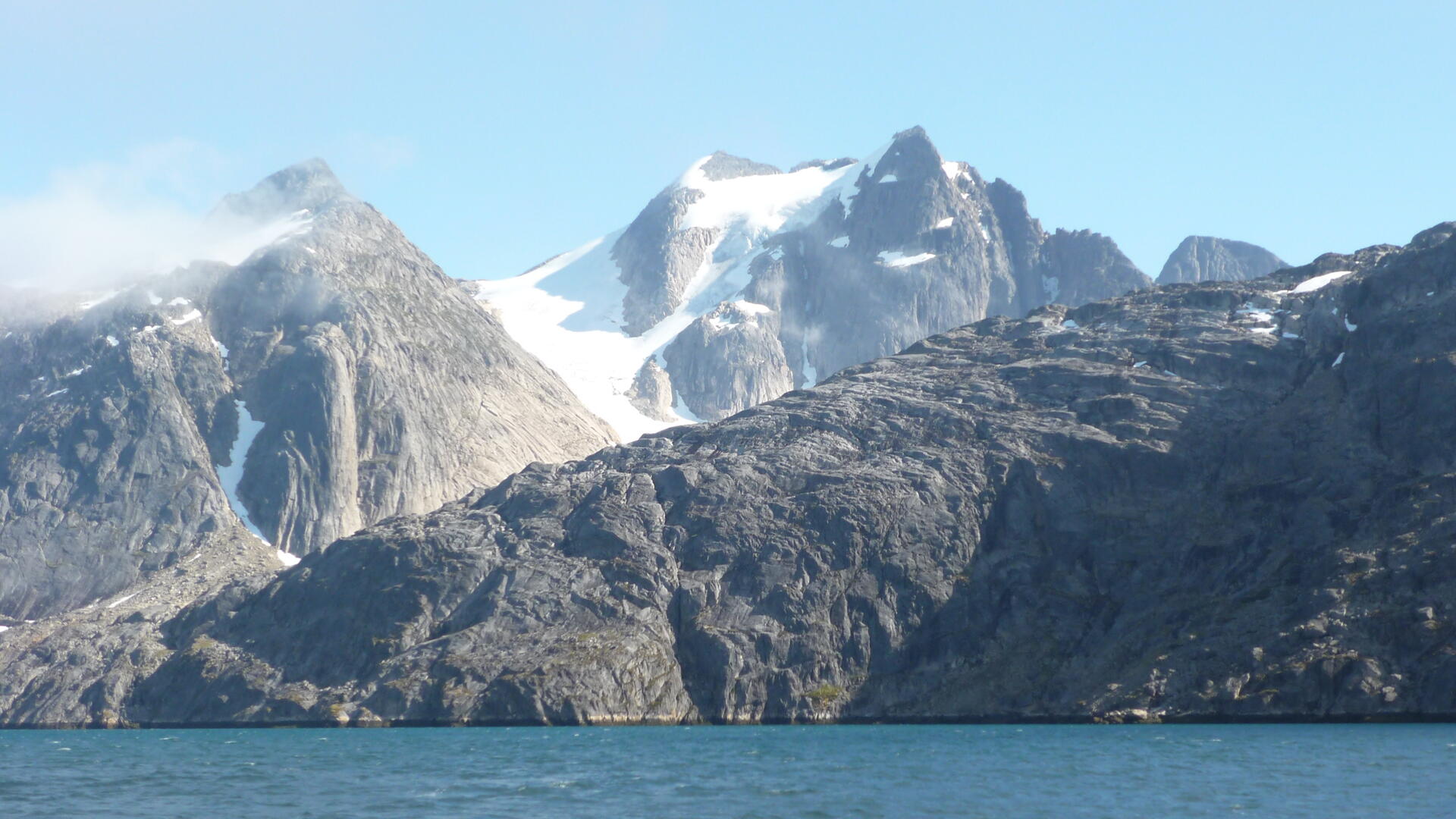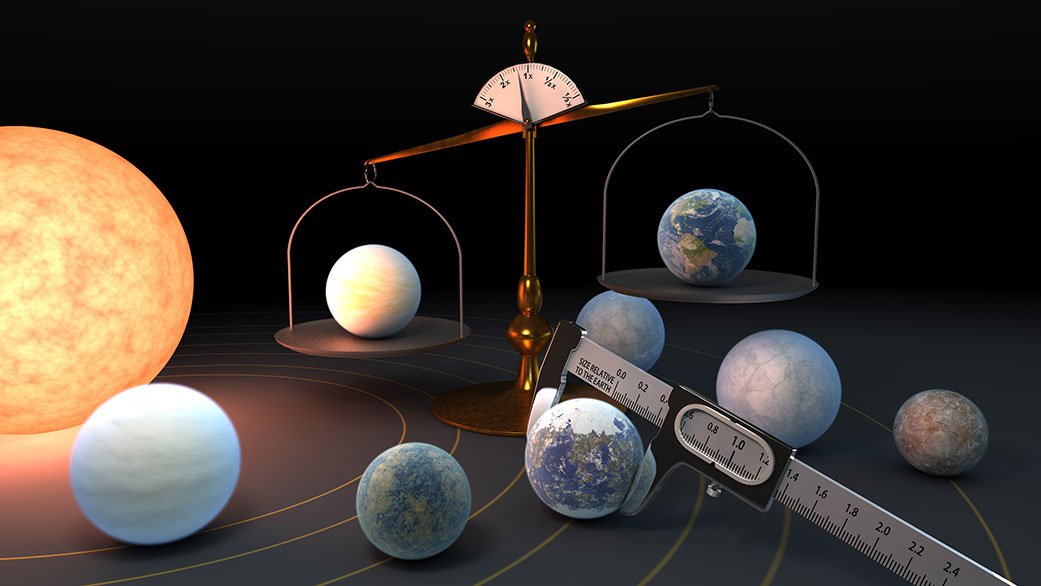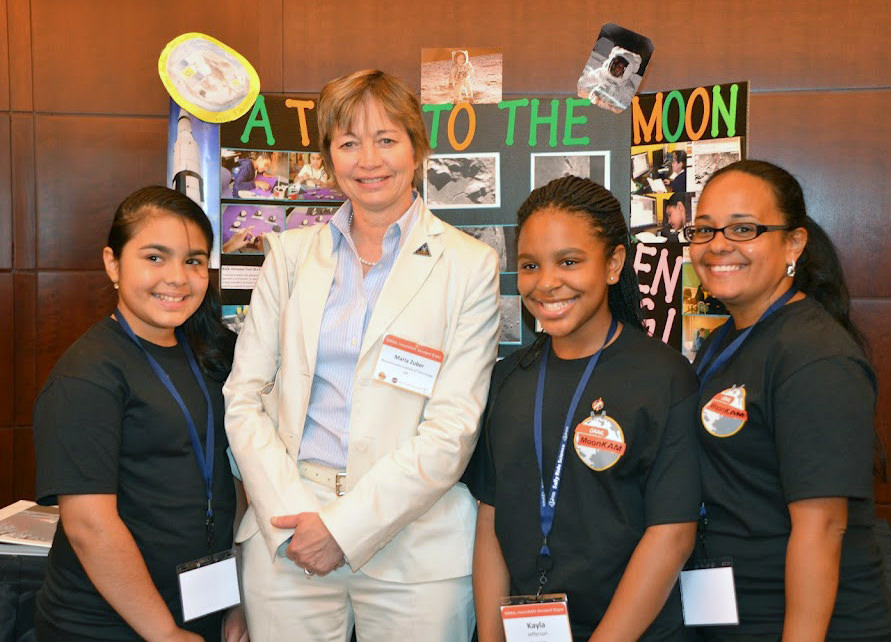In early 2012, an international research team surveying parts of southwestern Greenland announced that they had discovered the oldest impact crater ever discovered on Earth, estimated at 3.3 billion years old. Now, new research shows that the strange geological feature – known as the Maniitsoq structure – is probably the result of Earthly geological processes, rather than a meteorite impact.
Continue reading “It Turns Out That the World’s Oldest Impact Crater Isn’t an Impact Crater”There are Seven Rocky Planets in the TRAPPIST-1 System and They’re Surprisingly Similar
The TRAPPIST-1 system has long be studied by exoplanet hunters due to its unique quantity of planets that happen to also be Earth sized. In a recent paper, a team of scientists led by Eric Agol at the University of Washington, dove into more detail on the density of the seven known planets in the system, and, surprisingly, found that they were all very similar.
Continue reading “There are Seven Rocky Planets in the TRAPPIST-1 System and They’re Surprisingly Similar”Lakes On Titan Will Have Layers, Like Lakes On Earth, But for a Completely Different Reason
Lakes on Earth are a common sight in many locales. They’re central to the recreation and livelihood of millions of people. Few of those people think of the hydrodynamics that happen in a lake system. It is common for lakes to stratify into different layers. On Earth that stratification is the result of the sun heating the upper layer of water, which then becomes less dense and floats on top of the colder, more dense layer beneath it. Now, scientists from the Planetary Science Institute (PSI) have found similar dynamic cycles in a different kind of lake – the ethane and methane lakes on Titan.
Continue reading “Lakes On Titan Will Have Layers, Like Lakes On Earth, But for a Completely Different Reason”Did Jupiter Push Venus Into a Runaway Greenhouse?
Venus has been garnering a lot of attention lately, though primarily in the scientific community as the last Hollywood movie about the planet was released in the 1960s. This is in part due to its dramatic difference from Earth, and what that difference might mean for the study of exoplanets. If we can better understand what happened during Venus’ formation to make it the hell scape it is today, we might be able to better understand what truly constitutes the habitable zone around other stars.
Numerous planetary scientists have focused on Venus’ formation and atmospheric development in the recent past. Now a new paper posits that Venus might have had liquid water on its surface as recently as one billion years ago. And a contributor to the disappearance of that water might be an unlikely culprit: Jupiter.
Continue reading “Did Jupiter Push Venus Into a Runaway Greenhouse?”On Mars, mud flows like lava

One of the most striking features on Earth are the curious flows of lava as it cools, forming undulating ropes of rock known by the Hawaiian word pahoehoe. New research simulating conditions on Mars now reveals that the red planet has its own kind of pahoehoe…but made of mud.
Continue reading “On Mars, mud flows like lava”Trump Proposes $19.1 Billion 2018 NASA Budget, Cuts Earth Science and Education
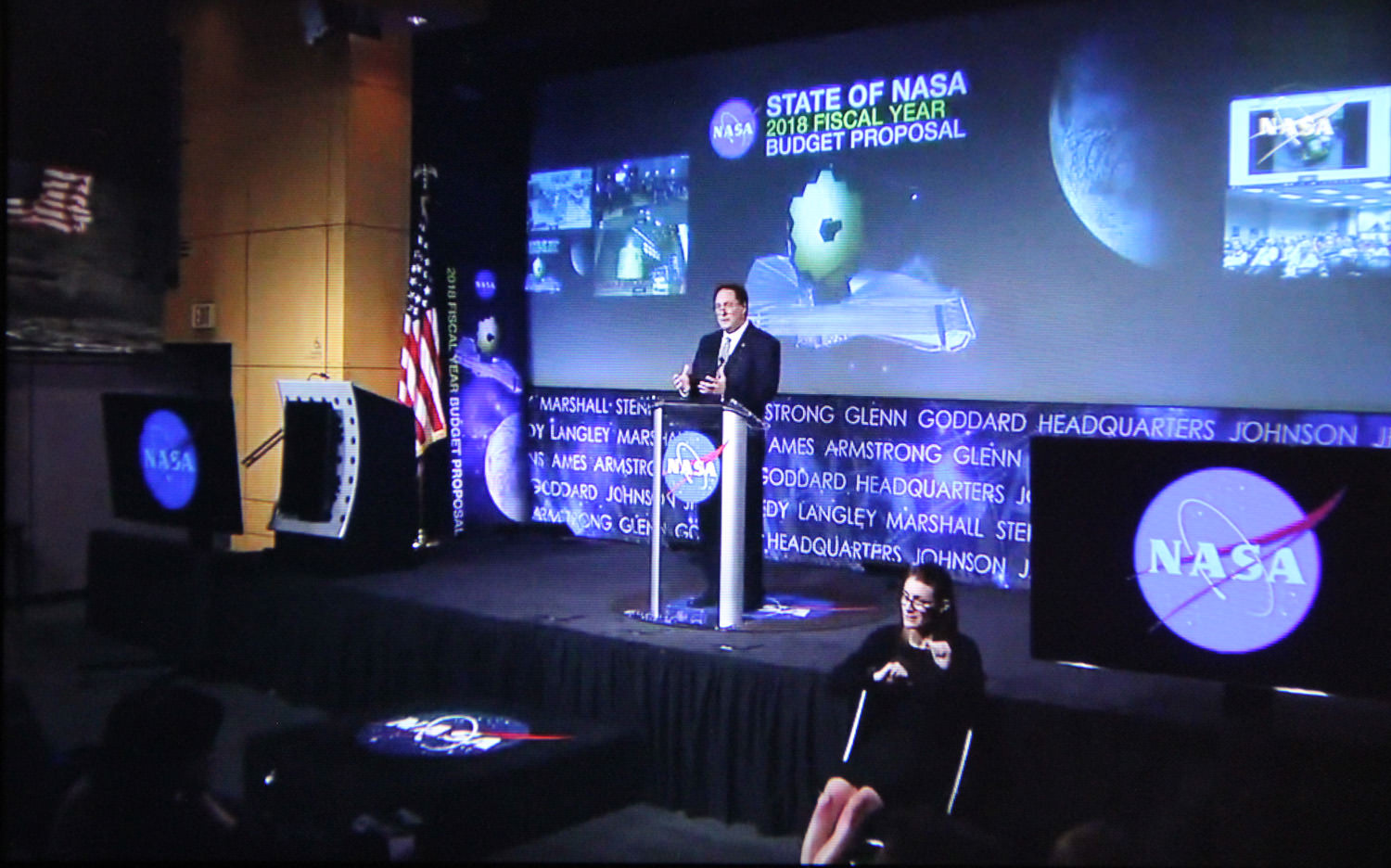

The Trump Administration has proposed a $19.1 Billion NASA budget request for Fiscal Year 2018, which amounts to a $0.5 Billion reduction compared to the recently enacted FY 2017 NASA Budget. Although it maintains many programs such as human spaceflight, planetary science and the Webb telescope, the budget also specifies significant cuts and terminations to NASA’s Earth Science and manned Asteroid redirect mission as well as the complete elimination of the Education Office.
Overall NASA’s FY 2018 budget is cut approximately 3%, or $560 million, for the upcoming fiscal year starting in October 2017 as part of the Trump Administration’s US Federal Budget proposal rolled out on May 23, and quite similar to the initial outline released in March.
The cuts to NASA are smaller compared to other Federal science agencies also absolutely vital to the health of US scientific research – such as the NIH, the NSF, the EPA, DOE and NIST which suffer unconscionable double digit slashes of 10 to 20% or more.
The highlights of NASA’s FY 2018 Budget were announced by NASA acting administrator Robert Lightfoot during a ‘State of NASA’ speech to agency employees held at NASA HQ, Washington, D.C. and broadcast to the public live on NASA TV.
Lightfoot’s message to NASA and space enthusiasts was upbeat overall.
“What this budget tells us to do is to keep going!” NASA acting administrator Robert Lightfoot said.
“Keep doing what we’ve been doing. It’s very important for us to maintain that course and move forward as an agency with all the great things we’re doing.”
“I want to reiterate how proud I am of all of you for your hard work – which is making a real difference around the world. NASA is leading the world in space exploration, and that is only possible through all of your efforts, every day.”
“We’re pleased by our top line number of $19.1 billion, which reflects the President’s confidence in our direction and the importance of everything we’ve been achieving.”
Lightfoot recalled the recent White House phone call from President Trump to NASA astronaut & ISS Station Commander Peggy Whitson marking her record breaking flight for the longest cumulative time in space by an American astronaut.
Thus Lightfoot’s vision for NASA has three great purposes – Discover, Explore, and Develop.
“NASA has a historic and enduring purpose. It can be summarized in three major strategic thrusts: Discover, Explore, and Develop. These correspond to our missions of scientific discovery, missions of exploration, and missions of new technology development in aeronautics and space systems.”
Lightfoot further recounted the outstanding scientific accomplishments of NASA’s Mars rover and orbiters paving the path for the agencies plans to send humans on a ‘Journey to Mars’ in the 2030s.
“We’ve had a horizon goal for some time now of reaching Mars, and this budget sustains that work and also provides the resources to keep exploring our solar system and look beyond it.”
Lightfoot also pointed to upcoming near term science missions- highlighting a pair of Mars landers – InSIGHT launching next year as well as the Mars 2020 rover. Also NASA’s next great astronomical observatory – the James Webb Space Telescope (JWST).
“In science, this budget supports approximately 100 missions: 40 missions currently preparing for launch & 60 operating missions.”
“The James Webb Space Telescope is built!” Lightfoot gleefully announced.
“It’s done testing at Goddard and now has moved to Johnson for tests to simulate the vacuum of space.”
JWST is the scientific successor to the Hubble Space Telescope and slated for launch in Oct. 2018. The budget maintains steady support for Webb.

The Planetary Sciences division receives excellent support with a $1.9 Billion budget request. It includes solid support for the two flagship missions – Mars 2020 and Europa Clipper as well as the two new Discovery class missions selected -Lucy and Psyche.
“The budget keeps us on track for the next selection for the New Frontiers program, and includes formulation of a mission to Jupiter’s moon Europa.”
“SLS and Orion are making great progress. They are far beyond concepts, and as I mentioned, components are being tested in multiple ways right now as we move toward the first flight of that integrated system.”
NASA is currently targeting the first integrated launch of SLS and Orion on the uncrewed Exploration Mission-1 (EM-1) for sometime in 2019.
Top NASA managers recently decided against adding a crew of two astronauts to the flight after conducting detailed agency wide studies at the request of the Trump Administration.
NASA would have needed an additional $600 to $900 to upgrade EM-1 with humans.
Unfortunately Trump’s FY 2018 NASA budget calls for a slight reduction in development funding for both SLS and Orion – thus making a crewed EM-1 flight fiscally unviable.
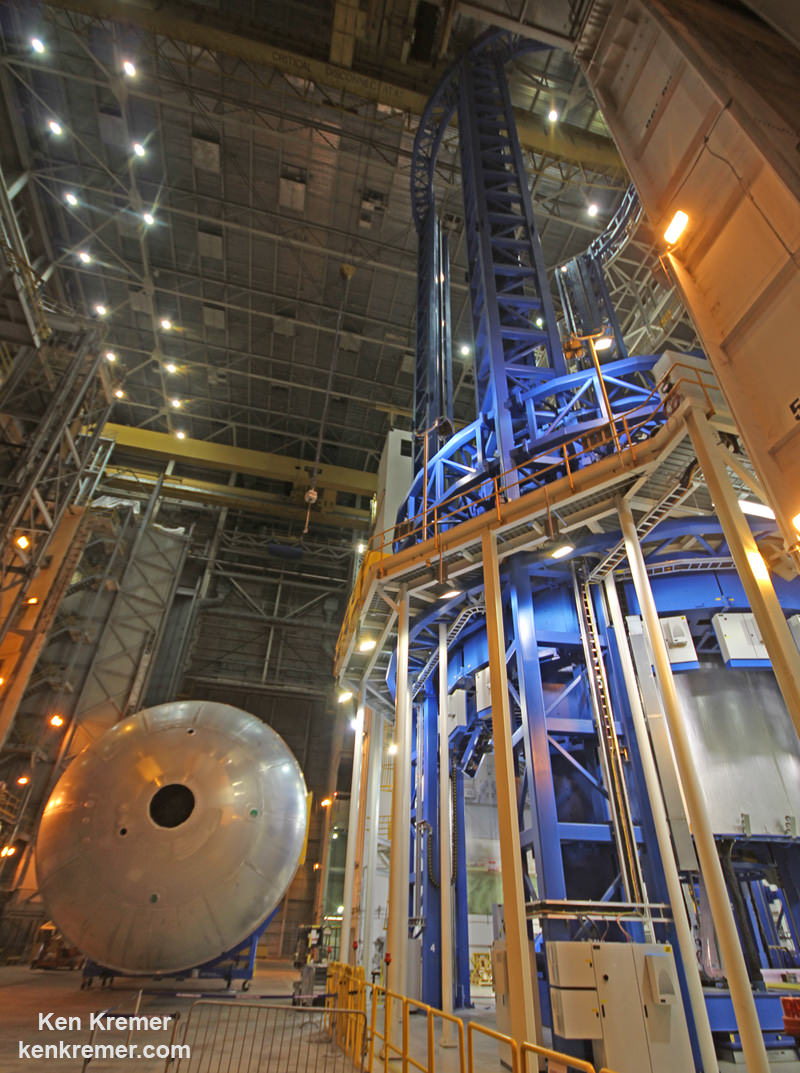
The budget request does maintain full funding for both of NASA’s commercial crew vehicles planned to restore launching astronauts to low Earth orbit (LEO) and the ISS from US soil on US rockets – namely the crewed Dragon and CST-100 Starliner – currently under development by SpaceX and Boeing – thus ending our sole reliance on Russian Soyuz for manned launches.
“Working with commercial partners, NASA will fly astronauts from American soil on the first new crew transportation systems in a generation in the next couple of years.”
“We need commercial partners to succeed in low-Earth orbit, and we also need the SLS and Orion to take us deeper into space than ever before.”
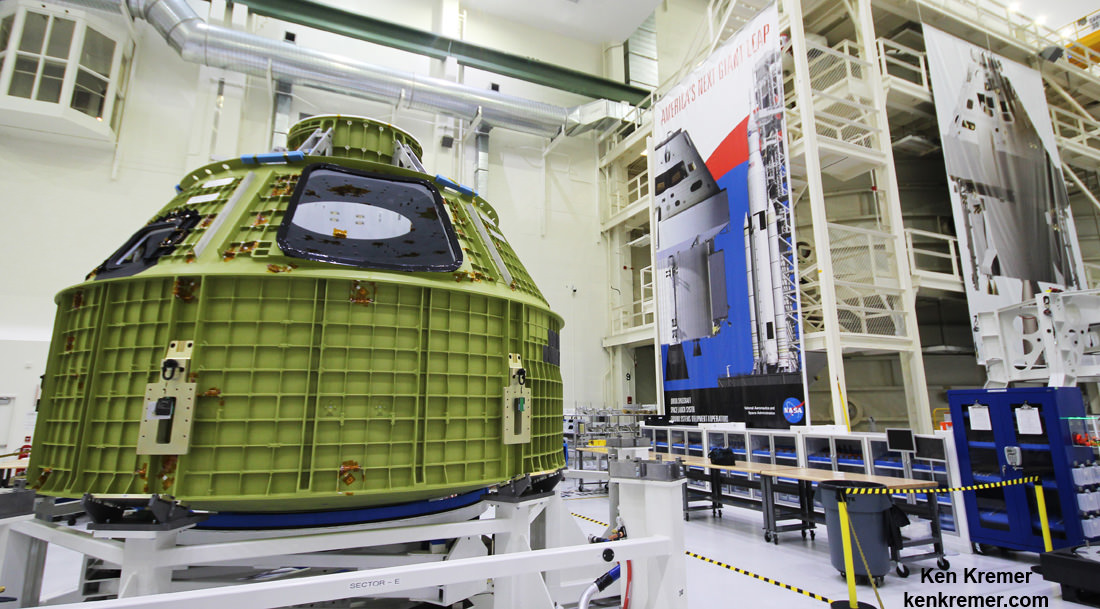
However the Trump Administration has terminated NASA’s somewhat controversial plans for the Asteroid Redirect Mission (ARM) – initiated under the Obama Administration – to robotically retrieve a near Earth asteroid and redirect it to lunar orbit for a visit by a crewed Orion to gather unique asteroidal samples.
“While we are ending formulation of a mission to an asteroid, known as the Asteroid Redirect Mission, many of the central technologies in development for that mission will continue, as they constitute vital capabilities needed for future human deep space missions.”
Key among those vital capabilities to be retained and funded going forward is Solar Electric Propulsion (SEP).
“Solar electric propulsion (SEP) for our deep space missions is moving ahead as a key lynchpin.”
The Trump Administration’s well known dislike for Earth science and disdain of climate change has manifested itself in the form of the termination of 5 current and upcoming science missions.
NASA’s FY 2018 Earth Science budget suffers a $171 million cut to $1.8 Billion.
“While we are not proposing to move forward with Orbiting Carbon Observatory-3 (OCO-3), Plankton, Aerosol, Cloud, ocean Ecosystem (PACE), Climate Absolute Radiance and Refractivity Observatory Pathfinder (CLARREO PF), and the Radiation Budget Instrument (RBI), this budget still includes significant Earth Science efforts, including 18 Earth observing missions in space as well as airborne missions.”
The DSCOVR Earth-viewing instruments will also be shut down.
NASA’s Office of Education will also be terminated completely under the proposed FY 2018 budget and the $115 million of funding excised.
“While this budget no longer supports the formal Office of Education, NASA will continue to inspire the next generation through its missions and the many ways that our work excites and encourages discovery by learners and educators. Let me tell you, we are as committed to inspiring the next generation as ever.”
Congress will now have its say and a number of Senators, including Republicans says Trumps budget is DOA.
Stay tuned here for Ken’s continuing Earth and Planetary science and human spaceflight news.
Weekly Space Hangout – June 24, 2016: Dr. James Green
Host: Fraser Cain (@fcain)
Special Guest:
Dr. James Green is the NASA Director of Planetary Science.
Guests:
Morgan Rehnberg (MorganRehnberg.com / @MorganRehnberg)
Dave Dickinson (www.astroguyz.com / @astroguyz)
Kimberly Cartier ( KimberlyCartier.org / @AstroKimCartier )
Their stories this week:
Evidence for volcanic history on Mars
Impact of Brexit on UK science uncertain
FRIPON: A New All-Sky Meteor Network
Blue Origin conducts fourth launch, test
We’ve had an abundance of news stories for the past few months, and not enough time to get to them all. So we are now using a tool called Trello to submit and vote on stories we would like to see covered each week, and then Fraser will be selecting the stories from there. Here is the link to the Trello WSH page (http://bit.ly/WSHVote), which you can see without logging in. If you’d like to vote, just create a login and help us decide what to cover!
We record the Weekly Space Hangout every Friday at 12:00 pm Pacific / 3:00 pm Eastern. You can watch us live on Google+, Universe Today, or the Universe Today YouTube page.
You can also join in the discussion between episodes over at our Weekly Space Hangout Crew group in G+!
Weekly Space Hangout – Nov. 13, 2015: Daniel Stern, Project Scientist on NuSTAR
Host: Fraser Cain (@fcain)
Special Guest: Daniel Stern, Project Scientist on NuSTAR.
Guests:
Morgan Rehnberg (cosmicchatter.org / @MorganRehnberg )
Alessondra Springmann (@sondy)
Kimberly Cartier (@AstroKimCartier )
Continue reading “Weekly Space Hangout – Nov. 13, 2015: Daniel Stern, Project Scientist on NuSTAR”
Who was Gerard Kuiper?
In the outer reaches of the Solar System, beyond the orbit of Neptune, lies a region permeated by celestial objects and minor planets. This region is known as the “Kuiper Belt“, and is named in honor of the 20th century astronomer who speculated about the existence of such a disc decades before it was observed. This disc, he reasoned, was the source of the Solar Systems many comets, and the reason there were no large planets beyond Neptune.
Gerard Kuiper is also regarded by many as being the “father of planetary science”. During the 1960s and 70s, he played a crucial role in the development of infrared airborne astronomy, a technology which led to many pivotal discoveries that would have been impossible using ground-based observatories. At the same time, he helped catalog asteroids, surveyed the Moon, Mars and the outer Solar System, and discovered new moons.
Astronomy Cast Ep. 361: Modern Women: Maria Zuber
Maria Zuber is one of the hardest working scientists in planetary science, being a part of six different space missions to explore the Solar System. Currently, she’s the lead investigator for NASA’s GRAIL mission.
Visit the Astronomy Cast Page to subscribe to the audio podcast!
We record Astronomy Cast as a live Google+ Hangout on Air every Monday at 12:00 pm Pacific / 3:00 pm Eastern. You can watch here on Universe Today or from the Astronomy Cast Google+ page.

